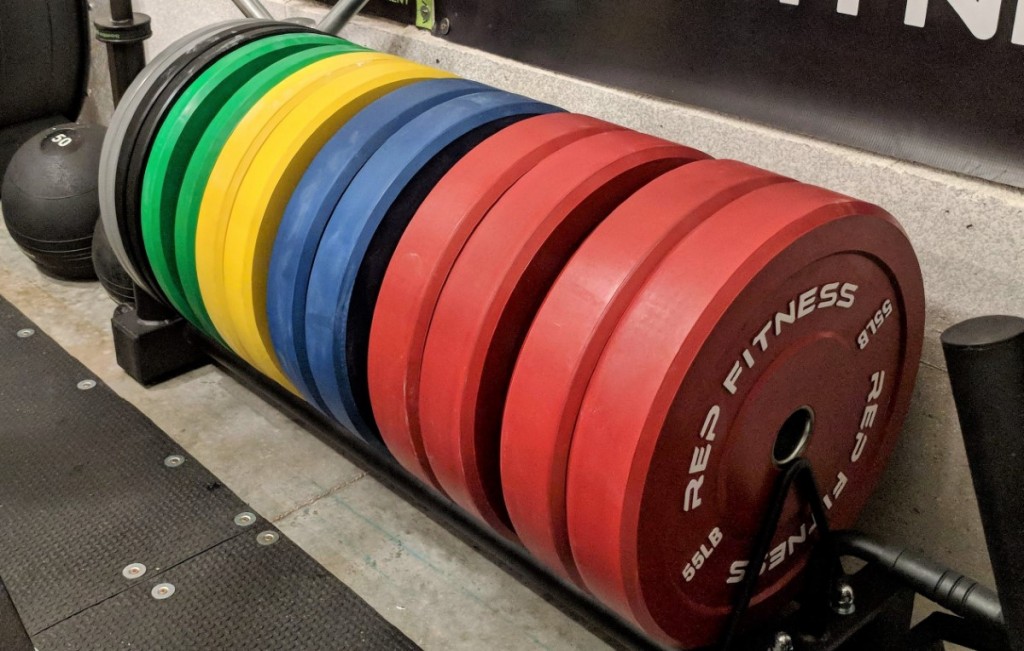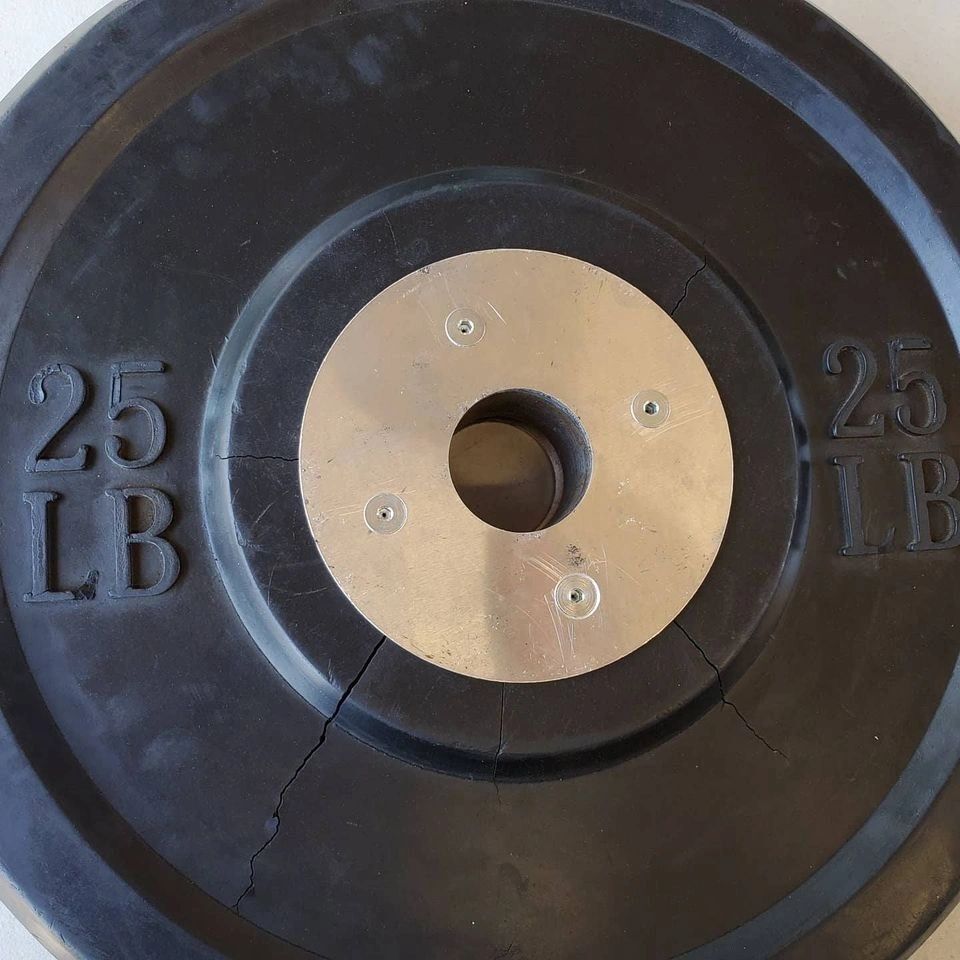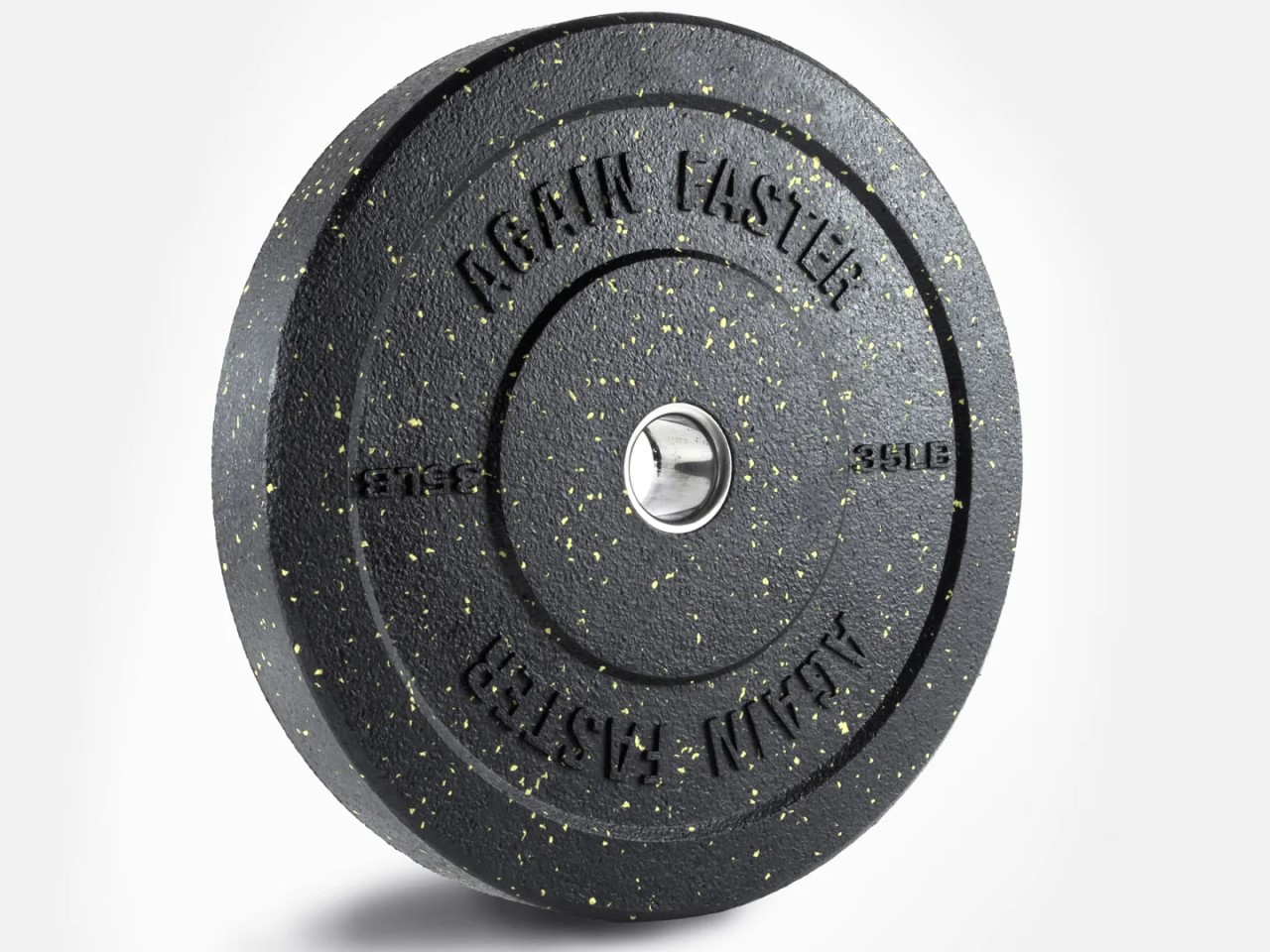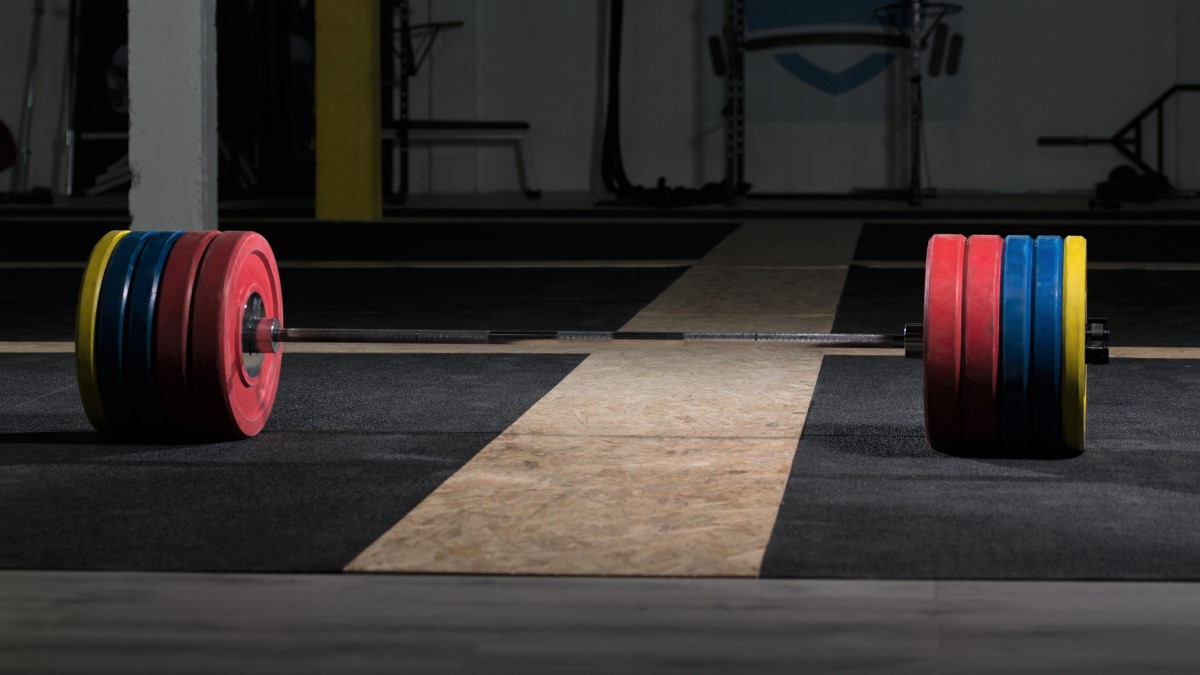Here are answers to the most frequently asked questions on bumper plates…
Table of Contents
What Are Bumper Plates?
Bumper plates – or bumpers for short – are olympic weight plates made of solid rubber, with a steel insert around the center hole to prevent the rubber from warping and to facilitate a smooth slide onto a barbell sleeve. Unlike plates that are merely rubber coated, the large rubber content of bumpers make them able to hit the floor without being damaged when the barbell is dropped from overhead. The lifts where this is done are normally the clean-and-jerk and the snatch, the two lifts scored in olympic weightlifting competitions.
What Diameter Are Bumper Plates? Are They All the Same Size?
The standard is 450mm diameter, or about 17.72″, as per the International Weightlifting Federation (IWF) equipment regulations.
While at this point the majority of bumper plates are 450mm, some manufacturers don’t conform to it. Hi-Temp bumpers may be anywhere from 441mm to 450mm diameter, depending on the distributor they’re made for. Some other manufacturers ignore the millimeter spec and instead make them to 17.5″ diameter.
All weights are the same diameter. Sometimes a manufacturer will do 450mm for bumpers 25lb and up and make their 10lb bumpers a tad smaller. 10lb bumpers are notoriously thin and could be damaged if they are the first ones to hit the floor from a barbell being dropped awkwardly.
How Much Do Blue, Red, Green, and Yellow Bumper Plates Weigh?

As with the diameter, the color convention is from the International Weightlifting Federation (IWF) equipment regulations. We call them bumpers, while they call them “discs”.
| Red | Blue | Yellow | Green | White |
| 25kg | 20kg | 15kg | 10kg | 5kg |
| 55lb | 45lb | 35lb | 25lb | 10lb |
The table above lists the official colors in kilograms, the international unit of weight used by the IWF and the Olympic Games.
The pounds shown in the table is what American companies use as the ballpark equivalent weight for their bumpers. 10lb bumpers are rarely white and are more often grey or black. This conversion to pounds is very rough. For example, 15kg = 33lb. Weights like 35lb are used only because it makes the math easier. Bumpers will have either the kg or lb weight marked on their face. Because the conversion used is not exact, you shouldn’t mix them.
At or under 5kg/10lb, bumper plates start to get too thin, and iron plates or rubber-coated iron plates are used instead. These are of a smaller diameter and are not meant to hit the ground the way bumper plates are.
Do You Need Bumper Plates for Deadlifts?
Bumpers are generally not needed for deadlifting. Bumpers will spread the force out a little as they impact the floor. But you should have some kind protective rubber flooring anyway, and with that it shouldn’t matter what kind of plates you use.
When you see people deadlifting with bumpers, it might be for a few other reasons.
First, bumpers might be what’s available. Some people do some olympic lifts – cleans or snatches – and have bumpers for that, and they might find it preferable to get another pair of bumpers for deadlifts instead of a whole set of iron plates that they need to get another storage rack for.
Second, most manufacturers of bumpers make them to a standard 450mm / 17.72″ diameter, ensuring the bar is at the exact same starting height on the floor every time. Iron plates aren’t this size as often. It depends on the make and model. The most common iron plates everywhere, marked with “Standard Barbell” on the face, are usually not quite that size.
Third, sometimes you see people with bumper plates because they figure those will be easier on the floor, bar, and plates than iron would be. It isn’t necessarily true.
Fourth, bumpers are quieter than iron as you’re loading and unloading them on the bar. Rubber coated iron plates would be about the same, but those are almost never the right diameter.
Do You Need Bumper Plates for Power Cleans?
Rip demonstrates the answer to this question in the video. If you’ve drilled the movement enough at light weight, are reasonably careful and have some kind of rubber flooring (Rip uses a platform here), the plate material doesn’t make a big difference.
When you’re doing cleans – as opposed to the power cleans Rip is doing – you are doing a full squat to catch the bar off the pull, which makes it more likely you will lose your balance or otherwise fail to squat the weight and have to dump the bar. That makes for a better argument that bumpers would help protect everything.
As far as doing the clean-and-jerk or snatch, where you’re definitely going to have some big drops, you need bumpers.
Are Bumper Plates Worth It?
The price jump from iron plates varies. It depends on what kind you’re looking at. On average you might pay about 20-30% more for bumper plates than iron plates.
A better comparison is iron plates that are machined to 450mm diameter and a +/-2% weight tolerance, which are a little more expensive than cast iron plates that have little or no machining and might be 5% off weight. Rogue’s HG 2.0 Bumpers are only about 10% more than their Deep Dish plates. Bells of Steel’s bumpers are currently the same price as their machined iron plates, or for the 45lb plates anyway.
As to whether you’ll benefit enough from bumpers to make them worth it, I’ve tried to give that answer in the preceding questions as far as certain exercises go.
How Many Bumper Plates Do You Need?
To start with, get a pair of 45lb, 25lb, and 10lb bumpers, plus a pair of 5lb and 2.5lb iron plates. Along with the 45lb bar, that will get you up to 220 lbs. 35lb and 55lb bumpers aren’t necessary. Add more 45lb plates from there as needed.
For kg sizes, the equivalent recommendation is getting a pair of 20kg, 10kg, and 5kg bumpers, plus 1kg and 2kg iron plates, and adding more 20kg bumpers as needed. Competitive and international olympic lifters use the 25kg bumpers more often. Most lifters in the US prefer to stick to the habit of 45lb/20kg being the largest plate.
Will Bumper Plates Crack Concrete?
Most bumper plates can crack and pulverize concrete. That isn’t to say that they always will. Not all concrete is equal. The best mixes of concrete will take it. The more common cheaper concrete mixes won’t.
Crumb rubber bumpers like Hi-Temp are made to drop on concrete without damaging it. The rubber is so soft that the force is absorbed by the bumpers as they deform on impact and bounce a lot, and the force isn’t transferred much to the concrete.
Other bumpers, whether garden variety style bumpers or competition style bumpers with large steel plates, will hit the concrete pretty hard. Unless you’ve got faith in the quality of your concrete, use some 3/4″ rubber flooring, or better yet a lifting platform consisting of rubber and wood to spread out the force even more. I go over this in the gym flooring guide.
How Do You Repair Bumper Plates?
WodHardware has a guide on gluing loose bumper plate inserts back into place using a 5-minute epoxy syringe, along with masking tape to protect the bar and acetone to clean up.
To prevent that problem next time, buy bumpers with inserts anchored into the rubber.

For another option to stabilize the inserts or to deal with cracking rubber, a mystery person started selling a repair kit of aluminum plates and screws, the same kind of kit WodHardware used to sell, sandwiching the center portion of the bumper between two lightweight aluminum plates. You still need a drill, drill bits, allen wrenches, and thread locker. No company or location info, only an email address. He has no online checkout, just an annoying PDF order form you have to fill out and email in.
What Are Crumb Bumper Plates?

Crumb rubber bumpers have a rough, porous texture, made of recycled rubber ground up into crumbs. Due to the low density, they are thicker and bouncier than other bumpers.
Their biggest appeal is they won’t damage bare concrete. The rubber is so soft that the force is absorbed by the bumpers as they deform on impact and bounce pretty high, and the force isn’t transferred much to the concrete.
On the downside, the 10lb bumpers are susceptible to folding over and being permanently damaged if they are the only bumpers used on a barbell, due to the thin, soft rubber not holding its shape very well under that kind of pressure. Crumb bumpers are also often not made to a standard 450mm diameter.
What Are Mil Spec Bumper Plates?
It sounds intriguing, doesn’t it. Is it milligram or perhaps millimeter spec? Maybe these are super accurate?
No, “mil spec” merely means military spec. The US military has specs for the equipment to be used for the Army Combat Fitness Test (ACFT) 3.0, and they’re a big buyer, so manufacturers are making some special plates for them. I haven’t been able to find the required equipment specs for the ACFT 3.0, launched in 2021. The info most readily available is their old requirements from 2018. From the product detail pages, it’s pretty similar to other econ style bumpers, perhaps with specific shore durometer (rubber hardness) ratings, thickness, and things like that. Rogue’s mil-spec bumpers are harder than Hi-Temp bumpers but softer than their HG bumpers.
How Do You Get Rid of Bumper Plates’ Smell?
I wrote an article on dealing with the odor from rubber coated plates and bumper plates.
With stinky bumpers the odor is normally the rubber off-gassing, and it won’t last forever. There are ways to speed it up and mitigate the fumes during this period.
Where Should I Buy Bumper Plates?
You should shop at a specialty gym equipment store. Good brands have the steel inserts anchored into rubber so that they won’t loosen or pop out, or the inserts are at least recessed into the face of the plate so that there’s no steel-on-steel contact with other bumpers, which is what tends to knock them loose. They pick the right shore durometer (hardness rating) of rubber, sometimes using a softer rubber for the center portion of the bumper by the insert to prevent undue pressure on it, or a harder rubber for the 10lb and 15lb bumpers to make them stiff and droppable without folding. The makers of cheap off-brand bumpers don’t put these kinds of considerations in.
A couple of the best places to buy known good quality bumpers are Rogue and FringeSport.

